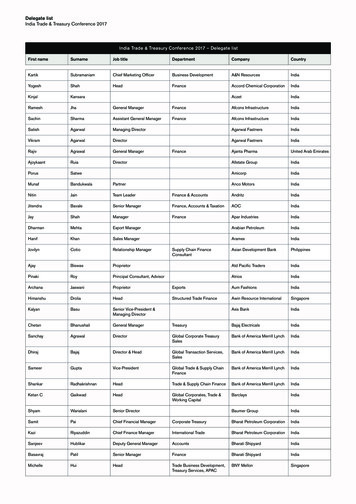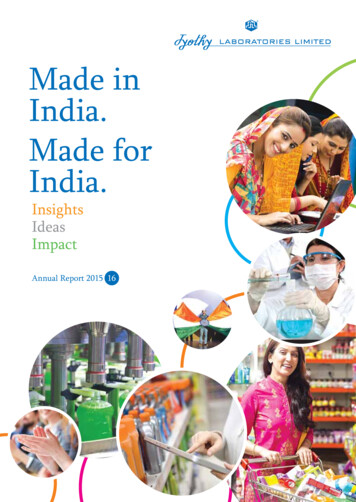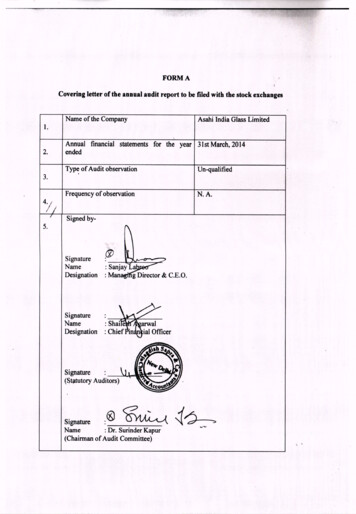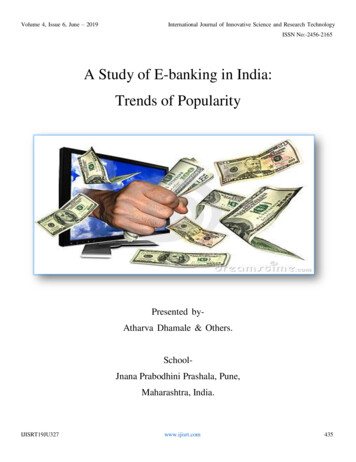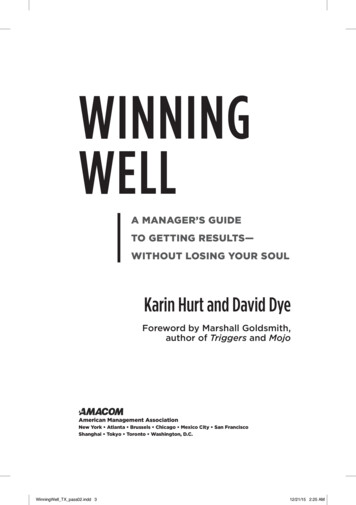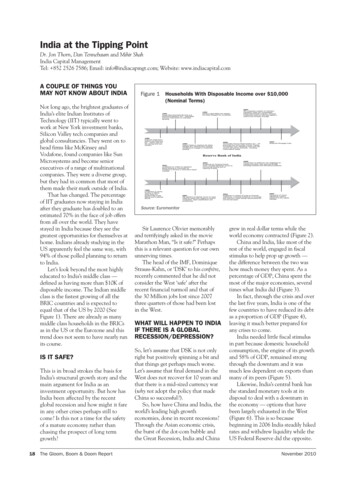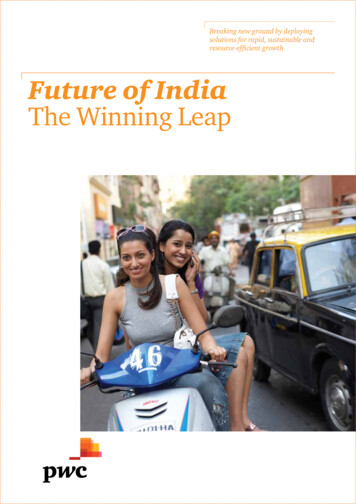
Transcription
Breaking new ground by deployingsolutions for rapid, sustainable andresource-efficient growthFuture of IndiaThe Winning Leap
Table of contents2 Preface4Executive summary18Chapter 1:Growth ambitionand exemplarspwc.in/thewinningleap32Chapter 2:Sectoral challengesand the Winning Leap
72Chapter 3:Role of the privatesector: Building capabilities88Chapter 4:Entrepreneurialsector96Chapter 5:The ease of doingbusiness140 Appendix I:List of interviews143 Appendix II:PwC Contributors108128Chapter 6:Capitalising onIndia’s growth storyChapter 7:Realising our ambition144 Appendix III:ResearchMethodology
2 2 PwCPwC
Future of IndiaThe Winning LeapPrefaceA young India, with a large digitally enabled middle class is asking for growth and change.Without building the skills and capabilities necessary to drive innovation, the nation risksstagnation. However, if India can create capabilities for growth and new solutions, theopportunities, both at home and abroad, are limitless.Our report, Future of India - the Winning Leap is driven by the belief that India can buildshared prosperity for its 1.25 billion citizens by transforming the way the economy createsvalue. Corporate India has a critical role to play in this story, not only by creating value byaddressing key societal needs, but in supporting a vibrant entrepreneurial sector. Additionally,it needs to partner with the government in order to implement new developmentalapproaches.PwC’s analysis of key sectors such as education, healthcare, agriculture, financial services,power, manufacturing, retail, urbanisation, digital and physical connectivity suggests thatnew solutions are necessary in each sector. These Winning Leap solutions will enable sectoralgrowth with a fraction of the resources to attain desired outcomes. As the world increasinglyconfronts technological change and sustainability challenges, we believe India and theWinning Leap can offer an exemplar for other growth markets. Our report also outlines howgovernment will need to create national platforms and improve the ease of doing business.A sixth of humanity, with the intellect, energy and creativity of a young nation is poised togrow rapidly. At PwC, we are energised and humbled by this opportunity and the benefits thatcan flow to India’s citizens, its businesses, investors and the government. This journey willhave its own sets of challenges, and by no means guarantees growth. But, with a concertedeffort we believe rapid, equitable and sustainable growth is achievable.As a global business with over 9,000 people in India and a 130-year relationship with thecountry, the possibilities highlighted by the report are exciting. PwC is committed to playingits role in India’s Winning Leap.Dennis NallyChairmanPricewaterhouseCoopersInternational LimitedDeepak KapoorChairmanPricewaterhouseCoopers IndiaJuan PujadasVice ChairmanGlobal Advisory ServicesPricewaterhouseCoopersInternational LimitedFuture of India 3
Executivesummary4PwC
The Winning LeapNoun; Breaking new ground by deploying solutions for rapid, sustainable, andresource-efficient growth; a play-to-win approach by young and growing nationsseeking a radically different development path; a phrase denoting small stepsby millions of people that can culminate in a giant leap forward for their nation;a phrase that citizens, entrepreneurs, business leaders, investors and governmentleaders associate with a ‘once-in-a-lifetime opportunity’ to lift millions intoprosperity; an approach that industry leaders can use to build new capabilitiesfor profitable growth; a state of mind focused on possibilities while recognisingroadblocks in solving a wide set of challenges facing a nationIn its seventh decade of independence, India stands on the cusp ofmajor change: a transformationthat could lead to unprecedentedeconomic growth paired with radical improvements in the nation’sHuman Development Index (HDI).Over the past two decades, India’sgross domestic product (GDP) hasrisen by more than US 1tr, in theprocess bringing millions of citizensinto a new cohort we call the emerging middle class. We set out tounderstand what it would take forIndia to increase its GDP by 9% peryear to become a US 10tr economyover the coming two decades.Anything less than US 10tr wouldnot secure India’s future. The nationneeds to create 10-12m jobs everyyear in the coming decades toprovide quality of life for its growingpopulation. Young Indians, particularly members of the emergingmiddle and the middle class—abillion strong by 2034—have risingaspirations. They are also moreempowered to demand change,thanks to ever-greater access to theinternet and mobile connectivity.The recent electoral mandate fordevelopment is a more immediatesignal of Indians’ desire for growthand for the benefits of growth to beextended to all members of society.A 9% GDP growth rate with a percapita income rising from US 1,500to just under US 7,000 per year willboost quality of life for more than1.25bn citizens. This would be thelargest national development effortany democracy has ever attempted.Reaching this goal will call for aconcerted effort—from businesses,entrepreneurs, investors, and government leaders. It will also requirenew solutions we collectively termthe Winning Leap. Our researchfocuses on the role that corporations and entrepreneurs must playin helping to deliver this growthwhile building new capabilities.Future of India 5
The national ambition 10.4 trillionBuilding a 10 trillion economyIf India continues on its present growth course, it could havea US 5.6 trillion economy in 20 years. To create a US 10 trillioneconomy, India will need to accelerate its growth to 9% CAGRover the next 20 years. 5.6 trillion 1.9 trillionBaseline2014Real GDP (US , 2010 prices)The Winning Leap2034Creating new capabilitiesFive key themes for the corporate sectorTo lead the Winning Leap, companies will have toaddress five key themes requiring new capabilities1ndinnovation mindsGrowth aCorporatecapabilitiesandredwem erpoustoEm ed crmfoinet5bility, integrity,un taocinabilityAcsustaan d422tiveapadelsdodmng3Non traditionaandlrpartne esorsh uipPwCanesrcsFlexop ibleerati6
Solving problems across sectorsAchieving the Winning Leap means finding solutions to some of India’s most persistent problems. As the country transforms,these must become vectors of growth not weights slowing the country’s rise.80 yearsHealthcare2034Raising lifeexpectancy201466 yearsEducationKeeping childrenin school10 years203420147 uctivity20144 tonnes/hectare90%FinancialservicesProvidingbanking tomore ng 25%of GDP2034201412% of GDP50%Retailshare2034Increasing themarket shareof organisedretail20148% share100%PowerMore and betterpower to morepeopleaccess2034201475% accessUrbanisationModernisingurban areas201435% access650 mnpeople20342014400 mn people80%DigitalconnectivityBroadeningthe networkManufacturingaccess2034201415% accessPhysicalconnectivityReducelogisticscost8%of GDP2034201413% of GDPTaking the right sub-leapsFierce Catch-upUsing traditionalapproaches or technologies—to surmount challenges—at an accelerated paceSignificant LeapLeapfrogAdopting new or differentapproaches and technologiesthat may have been developedelsewhere but that wouldalso work in IndiaSkip a generation or createan entirely new method ofbusiness model or technologyFuture of India 7
We also highlight the critical rolethat the government will haveto play to support this goal, bycreating national platforms andan enabling environment.Our research methodology comprised interviews with about 80leaders in India and abroad, workshops with sector leaders, insightsfrom academic and economicspecialists, and an online surveycompleted by more than 1,500 PwCemployees. The message we heardwas unambiguous: to surmount itschallenges and secure its future,India needs to focus on creatingnew solutions that will radicallyimprove its economic and humandevelopment performance.We began with an analysis of othercountries that have embarked on asimilarly ambitious growth journey,including exemplars from middleincome countries in Asia and LatinAmerica. China, for example,has shown remarkable economicgrowth, albeit under political andsocial circumstances that are verydifferent from those that characterise India. South Korea has vastlyimproved its HDI since 1983. And8PwCsince 2007, Brazil has been unleashing the power of its private sector toaccelerate its growth. In India, wefound double-digit growth storiesin key states that provide internalexamples of what the nation itselfis capable of.Challenges as opportunitiesTo realise the Winning Leap vision,India needs to view its manyeconomic and social challengesas opportunities for growth andrenewal. With this perspectivein mind, we investigated performance in ten sectors that, together,constitute more than 70% of India’sGDP. Each sector faces challengeswhose resolution will require newsolutions that are scalable, resourceefficient, and environmentallysustainable. For example, theeducation sector will have to deliverhigh-quality, formal education to7m additional children every yearover the next two decades. Yet withcurrent education investmentsestimated at just 3% of India’s GDP,achieving this target won’t be easyusing traditional strategies. India’shealthcare sector offers anothercase in point. To serve a growing
population, the sector will need100,000 additional doctors and300,000 additional nurses everyyear through 2034. But this sector,too, faces an investment challenge.Additional sectors we examined—agriculture, retail, utilities,manufacturing, financial services,urban infrastructure—all confronta similar challenge. Each has togrow, despite resource constraints.Managing this imperative willrequire significant new investmentand innovative approaches.Complicating things further, all ofthese sectors are interconnected: asetback in one spawns setbacks inothers; improvement in one enablesimprovements in others. As just oneexample, higher-quality educationand healthcare result in healthier,more skilled workers who can helpdrive growth and innovation inIndia’s manufacturing sector.In addition, we examined performance in what we call enablingsectors: India’s digital and physicalconnectivity. For each sector examined, we defined a key metric—a“vector of growth”—with whichto assess growth performance.(See previous page.) We arrived attargets for these vectors by lookingat countries at a similar stage ofgrowth and by consulting sectorexperts. With sectors that supportand enable growth in other sectors,like digital connectivity, we tooka more aggressive approach, imagining India reaching world classstatus by 2034.Vectors represent targets that mustbe achieved for the correspondingsector to help drive overall rapidgrowth in India. Moreover, eachvector has quantitative as well asqualitative submetrics. To illustrate,while increasing average years ofschooling matters, spending moretime in school won’t mean muchunless the quality of the educationalso improves. And that meansstrengthening curricula, drivinginnovation in the use of learningchannels, and improving teachertraining.A closer look at the WinningLeap solutionAs we investigated these vectors, wesaw that linear growth in each willnot be enough to enable the growthenvisioned for India. Given the complexity and scale of the challengesfacing India, the resources required,and the urgency of demands forchange coming from Indian citizens,sector players must deploy solutionsthat deliver nonlinear growth. Ouranalysis of sector growth suggestedthree categories of solutions.(See Figure A.)Figure A: Categories of Winning Leap solutionsFierce Catch-upUsing traditionalapproaches or technologies—to surmount challenges—at an accelerated paceSignificant LeapLeapfrogAdopting new or differentapproaches and technologiesthat may have been developedelsewhere but that wouldalso work in IndiaSkip a generation or createan entirely new method ofbusiness model or technologyFuture of India 9
Figure B: How new approaches could contribute to India’s economyLeapfrog40%New solutionsSignificant leap 10.4 tr* GDPFierce catch-up60%Unblocking andexecuting existingmetho ds 1.9tr* GDP20142034Source: PwC analysisEach sector of the Indian economywill need to execute solutions drawnfrom all three categories if India isto build its GDP to US 10tr in 2034and improve its HDI in an environmentally sustainable manner.Take the vector life expectancy atbirth as an example. To increase lifeexpectancy from today’s 66 years to80 years in 2034, our analysis showsthat a traditional approach wouldrequire the addition of 3.6m newhospital beds over the coming twodecades. A Winning Leap approachwill take a decidedly different tack,whereby healthcare-sector playersscale more operationally efficientbusiness models (Fierce Catch-up),encourage preventive healthcareand home care (Significant Leap),10PwCand adopt mobile health techniquesand technologies (Leapfrog).Combining these strategies couldreduce the number of additionalhospital beds needed by 1.2m whilestill boosting life expectancy to 80years in 2034. That reduction in thenumber of new beds could translateinto savings of more than US 90bnin capital expenditure on healthcaredelivery infrastructure.Other sectors can benefit similarly.For instance, a Winning Leapapproach that increases averageyears of schooling from 7 to 10in 2034 could save the educationsector US 170bn in cumulativeinvestments. And a Winning Leapapproach providing 24/7 accessto power for all citizens while
We are sitting at 1.2 billion, going on to 1.5 billion inpopulation. While this is a huge challenge it is also alarge opportunity. It will stretch our finite resourcesto the limit unless there are some breakthroughsin technology.Ajay Kumar MisraTata Global Beveragesincreasing power delivery threefold can be achieved throughapproaches that save US 200bnin capital expenditures.Our analysis suggests that up to40% of India’s US 10tr economyin 2034 could be derived from newsolutions. (See Figure B.) Suchsolutions could be successfullyimplemented with 25-30% lessresources than those required bytraditional solutions. Therefore,Winning Leap solutions not onlydrive rapid growth in a resourceefficient manner but also areenvironmentally sustainable. TheWinning Leap is more than just anew approach; it’s a “play to win”mind-set for sector leaders andthe country.These and other analyses areexplored closely in Chapters 1and 2 of this report.11
The private sector’s role inachieving the Winning LeapIndia’s private sector—establishedcorporations and entrepreneurialcompanies alike—can play a keyrole in developing and deployingWinning Leap solutions. Why? Theprivate sector is more nimble thanthe government and social sectorsin terms of its ability to craft newbusiness models and strategies andleverage new technologies. Giventheir experience with globalisation,these companies are well positionedto learn from and experiment withbest practices developed bytheir global peers. Internationalcompanies looking to participatein high-growth markets areequally well equipped to developrelevant solutions.12PwCThis growth journey will alsorequire public-private partneringin its broadest sense. To supportprogress in a number of sectors, thegovernment will need to continuebuilding national platforms such asimproved roads, ports, and physicalconnectivity as well as betterdigital infrastructure.If India can achieve a 9% per yeargrowth trajectory, its economywould become the world’s thirdlargest in 2034, after the US andChina. This achievement wouldcreate world-class companiesoriginating in India that developcapabilities essential for otherhigh-growth markets as well. Thesecompanies could successfully serveIndia’s already large and growingdomestic market while alsocompeting on the global stage.We anticipate that at least tenIndian companies will find aplace among the global top 100by size and scale if the nation canachieve its US 10tr GDP aspiration.These industry champions will notonly demonstrate unprecedentedgrowth themselves but also buildnew capabilities essential for ongoing innovation of new products,services, and business models.To foster the emergence of suchworld-class Indian companies,India’s private sector will haveto invest more in research anddevelopment (R&D), particularlyfor solutions to challenges facingemerging markets, where India hasalready established a leadershipposition. Indeed, our economicmodel shows that India’s WinningLeap will require an increase inR&D spending from 0.8% of GDPto 2.4% in 2034.
Five themes for thecorporate sectorAll too many Indian companiesstill don’t realise the changeshighlighted in our research. Forthose that are aware, many arenot responding swiftly enough. Toachieve the scale of transformationrequired for India’s Winning Leap,businesses in as much as 40% ofthe nation’s economy will have toexecute new solutions and buildnew capabilities. To accomplish this,companies must focus on excellingat five interconnected themes.(See Figure C.)These five themes are exploredin detail in Chapter 3, includinghow they interrelate and whichcapabilities and technologieswill prove most crucial for each.Figure C: Five key themes for the corporate sectorServing informed andempowered customersAs information grows (in both access and volume)and Indian consumers and businesses are more ableto apply this information in their decision making, theybecome more empowered. And with their increasedempowerment, they’ll demand ever more value fromthe products and services they buy—including greaterquality and convenience. Companies will need torethink their business models and competitivestrategies to profitably serve these customers.Creating flexible andadaptive operating modelsTo reach these more demanding customers, Indiancompanies must build new kinds of operating models,such as asset-light models; experiment withunconventional sales and distribution channels;and leverage technology in new ways.Drawing on nontraditionalresources and partnershipsTo acquire or build capabilities needed to drivegrowth, Indian companies can import knowledgeand technologies through models such as licensingand forge partnerships with the government andsocial-sector organisations.Adopting a growth andinnovation mind-setIndian companies must weave a commitment togrowth into their corporate DNA by fosteringcompanywide awareness of consumers’ needs,investing enough in R&D, and unlocking entrenchedorganisational structures and attitudes that areinhospitable to new solutions, new business models,and new approaches.Focusing on accountability,integrity, and sustainabilityTo drive rapid growth, Indian companies will needto align their top management and board to makeeveryone accountable for growth, embed integrity intotheir organisational culture, and uphold sustainabilityand social impact as core values of the organisation.Future of India 13
Entrepreneurs’ rolein the Winning LeapThe importance of easeof doing businessLike large, established corporationsin India, entrepreneurial companiesin India can play a critical role indeveloping and deploying WinningLeap solutions. Indeed, the largeIndian companies of tomorrow willemerge from the entrepreneurialsector of today. A groundswell ofentrepreneurial energy in Indiahas sparked recent, well-publicisedsuccesses in the e-commerce sectoralone, and our research suggeststhe potential for similarlyentrepreneurial growth in virtuallyall of India’s sectors.India’s private-sector players candeliver Winning Leap solutionsonly if regulations and governmentpolicies make it easy to do businessin India. In 2013, India ranked 134out of 189 economies in the WorldBank’s Ease of Doing Businessindex. Our analysis and discussionwith experts in this field suggestthat there is some low-hanging fruitthat could be harvested to improvethis ranking—in areas like ease instarting a company and in payingtaxes. Progress on these and otherfronts could improve India’s rank inthis index by more than 50 in just afew years. Other improvements willrequire more complex policy andmind-set changes. An additionalbenefit of improving ease of doingbusiness in India could take theform of greater confidence inIndia on the part of multinationalcompanies, which would translateinto larger flows of foreign directinvestment and know-how intoIndia, two essential ingredients forgrowth and innovation. The topic ofease of doing business is examinedin closer detail in Chapter 5.Our research has also focused onthe interplay between corporationsand entrepreneurs—in particular,how corporations can help bylinking new ventures to their supply chain and by mentoring andcoaching entrepreneurs on bestbusiness practices. In addition tobeing especially nimble in terms ofdriving innovation, entrepreneurialbusinesses have a huge potential tocreate the new jobs needed by theIndian economy. Our findings andanalyses related to entrepreneurs’role in the Winning Leap arediscussed in detail in Chapter 4.
Three economic-growthscenariosWith data and modeling fromOxford Economics, we’ve definedthree possible economic growthscenarios for India, each hingingon different strategies and achievements that could come fromcorporations, entrepreneurs, andthe government and each reflectinga different focus for investment:Scenario 1Scenario 2Scenario 3Pushing old waysfaster outlines a focuson investment ineducation, health, andother dimensions related tohuman capital. Our analysissuggests that in this scenario,India’s GDP could see a 6.6%compound annual growthrate (CAGR) between nowand 2034.Turbocharging investmentoutlines the impact of rapidand significant investment inphysical infrastructure andenvisions a 7 trillion for GDPleading up to 2034.The Winning Leap includesinvestment in both human andphysical capital (as in theprevious two scenarios) butalso focuses on investmentin R&D and innovation andenvisions a 9.0% CAGR forGDP between now and 2034.This scenario forecasts themost aggressive growth andis the only scenario thatwill generate the 240m newjobs that India’s growingpopulation needs over thenext 20 years. 10.4CAGR): 9%2034( 20 1 4 -trS2 7.4 trS1 6.8 trB 5.6 tr 1.9 tr2014B2016Baseline2018S1Scenario 12020S22022Scenario 22024Winning leap20262028203020322034ForecastSource: Oxford EconomicsThe Future of India 15
We have also highlighted thechallenges and roadblocks toachieving the identified growth inGDP. For instance, for Scenario 1,India will need to capitalise on itsdemographic dividend while alsomitigating the risk of mass unemployment among its youth, whichcould be amplified by unaddressedhealth and education problems.In Scenario 2, water scarcity andenergy security could jeopardiseinvestments in physicalinfrastructure. And in Scenario3, continued weakness in India’sintellectual-property protectionsystem could hurt investmentsin R&D and innovation. Thesescenarios are explored moreclosely in Chapter 6.How to use this reportThe central purpose of this reportis to drive action. We hope that theframeworks, analyses, and ideasfor action laid out in this documentwill help catalyse corporate leaders, entrepreneurs, investors, andgovernment officials to take actionsaimed at contributing to India’sWinning Leap:CorporationsIf you’re a senior executive at a corporation, you may findChapters 2, 3, and 4 of particular interest. These and otherchapters can help you spark dialogue on how your company canspur its own growth, craft Winning Leap solutions that benefit Indiaoverall, and set the stage for elevating your company to worldclass status. See pages: 32, 64 and 80EntrepreneursIf you’re an entrepreneur, you may want to pay especially closeattention to Chapter 4 as well as Chapters 2 and 3. Werecommend using these and other chapters to brainstorm ideasfor partnering with large, established corporations (such as beingmentored by a large corporation), for scaling your company, andfor stepping up creation of new jobs. See pages: 32, 64 and 80InvestorsIf you are an investor, Chapters 2 and 6 may be of particularinterest, because they explore sector opportunities, the differentgrowth options facing India, and the approximate size of theinvestment opportunity. International companies seeking to enterIndia, acquire Indian companies, or invest in other ways in India’sgrowth story will find this content equally useful. See pages: 32and 100GovernmentIf you’re a government leader, Chapters 2, 5, and 6 may be ofparticular interest to you. These and other chapters can help youand your colleagues explore ideas for improving ease of doingbusiness in India (for example, by working with an industry councilfocused on this goal) and collaborating with businesses to identifyshort- and medium-term actions that the government could taketo elevate India’s ranking in the Ease of Doing Business index.See pages: 32, 88 and 100These concepts are covered in greater detail in Chapter 7 (page 128).16PwC
By using this report, you can initiate new conversations that lead tolong-term capability building andprofitable growth for your organisation or institution. In doing so,you will be joining business leaders, entrepreneurs, investors, andgovernment officials who participated in our study—all of whomwere energised by the possibility ofIndia’s rapid growth and spread ofprosperity that our report outlines.The international leaders who tookpart in our study were especiallypassionate in their opinion thatwhile the Winning Leap is criticalfor India, it’s equally important forother growing economies. It is ourhope that business and governmental leaders in other such economieswill draw lessons from India’sexperience and make strides towardtheir own Winning Leap.17
18PwC
Chapter 1Growth ambitionand exemplarsWe are kept from our goal, not by obstacles,but by a clear path to a lesser goal.The Bhagavad GitaIndia today can best be describedas a restless nation, with calls forchange coming from almost everycorner of society. Internationaland domestic news media are rifewith critiques and warnings aboutIndia squandering its extraordinarypotential because of an outdatedsociopolitical system, and India’scitizens are exerting increasingpressure for institutional reforms.Yet many are doing more thanjust protesting India’s situation:they are actively seeking change.They recognise that given the scaleof the problems facing this vastnation, slow reform may not be anoption. They demand change andgrowth (both economic growth andimprovements in human well-being)now, and they believe it can happenin their lifetimes.India’s youth want to make aneconomic and social difference.Members of a burgeoning emergingmiddle class are looking for new,customised solutions to addressunmet needs. Citizens and consumers are feeling informed andempowered to demand as well asdrive change. Citizen organisationsare pushing to ensure that economicgrowth is accompanied by equallyvaluable improvements in humandevelopment. In the sections thatfollow, we take a closer look atthese calls for change.Future of India 19
A young country with risingexpectationsIndia is a young country; nearly65% of its population is youngerthan 35.1 It has an opportunity todrive economic growth on the backof its rising working-age population(those aged 15-64). This populationhas boasted a compound annualgrowth rate (CAGR) of 2% since2000,2 a situation often referred toas India’s demographic dividend.The nation is expected to addalmost 10-12m people to its workforce every year over the next twodecades, with the working-agepopulation crossing the 1bn markby 2030.3 (See Figure 1.1.) Asother growing economies confronta rapidly greying population,India’s young population couldfulfill demand for skilledworkers worldwide.However, India risks squanderingthis demographic opportunity if itcannot create quality employmentopportunities at scale and train itsgrowing workforce to excel in thosejobs. With greater access to information and growing aspirations amongthe nation’s youth, the quality ofemployment that India provideswill prove as crucial as the quantity.Proliferation of newtechnologiesEmergence of new technologies,especially mobile, in India hassparked social change that’s difficult to quantify. Mobile, Internet,and social media penetration andgrowth can be quantified, butdescribing the changes in social20PwCFigure 1.1: India’s working-age populationWorking-age population (15-64 IBBrazilSK1970India1980US1990United StatesSouth KoreaForecastSource: United Nations Development Programmevalues and lifestyles that haveaccompanied those trends isfar more challenging.A key outcome of the technologyrevolution in India has beenconnectivity, which has fueledunprecedented access to information. Millions of people who hadlittle means to join the nationaldiscourse can now gain new insightsinto the world around them. Farmersknow crop prices. Consumers understand global standards of productand service quality. Rural Indiansrecognise the differences betweenthe opportunities available to themand those available to their urban2000201020202030
counterparts. And citizens have amass forum for expressing theirpolitical opinions. The upshot ofthis connectivity revolution hasbeen empowerment of Indians.To understand the scope and scaleof this change, let’s start withteledensity,I which has improvedsubstantially thanks to mobiletelephony. The number of mobilesubscribers in India jumped from261m in 2007-2008 to 910min 2013-2014.4Along with telephony, Internetpenetration is soaring in rural andurban India. Urban India boasts137m Internet users; rural India,68m. Moreover, the number ofrural Internet users is growingby 58% annually.5Roughly 15% of active mobile-voicesubscribers access the Internetthrough their mobile phones.(India had 130m mobile-Internetuse
using traditional strategies. India's healthcare sector offers another case in point. To serve a growing . Future of India 9 population, the sector will need 100,000 additional doctors and 300,000 additional nurses every year through 2034. But this sector, too, faces an investment challenge.



